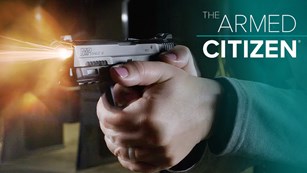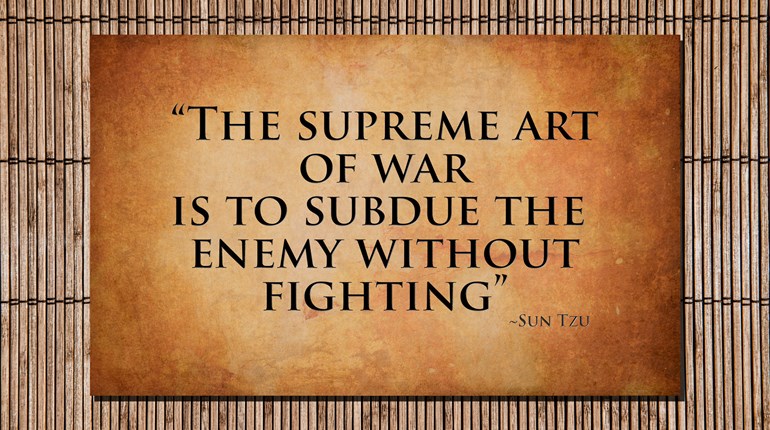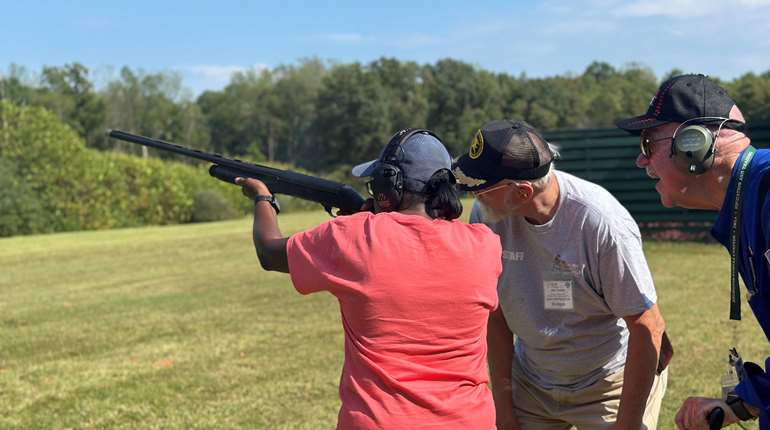
When you’re shooting a long gun from a standing position, the stance you adopt is important for a number of reasons. A proper stance will help you manage the gun’s recoil so you can get back on target for a second shot more quickly if needed. It will also keep you stable so you aren’t pushed around by recoil or easily knocked over. In shotgun shooting, a correct stance actually sets you up for a proper, comfortable shot. So what does the right stance look like? There are many fundamentals that don’t change, but there are also a few tweaks to make based on what kind of shooting you’re doing.

You’ll notice that these shooters all have slightly different stances—some are a little more straight-kneed, some like a wider foot position than others—but all have their feet shoulder-width part with their off-side foot forward, and all are leaning into the shot, placing more of their weight on their front foot.
Rifles and Aimed Shotguns, Off-Hand
When you’re shooting a rifle from a standing position, I recommend a relatively aggressive “fighting” stance that will help keep you stable, which in turn will help you manage recoil. Face the target directly and square your entire torso, including your hips, to the target. Your support-side foot (for right-handed shooters, that’s the left foot) should be a step forward, with your feet about shoulder-width apart. If your feet are too far apart, you won’t be able to move easily if you need to take a step, and if they’re too close together, you won’t feel stable. Point both feet toward the target, not to the side, which allows for quicker movement if needed, and make sure your hips stay square to the target. You want a little more of your weight on the front foot than on the back foot. Lean forward slightly from the hips and keep your knees relaxed or slightly bent.
Rifles, From Sticks
Standing-height shooting sticks are my favorite type of sticks. I find them easier to use and more comfortable to shoot off of—and much more flexible—than sticks I have to kneel or sit to use. When I’m shooting off of standing-height sticks, I use the same stance described above, with a slight variation: I like my sticks to be a little bit lower than my shoulders so I can bend a little more from my waist. This helps me lean into the sticks just a little bit, which offers stabilization—particularly helpful when it’s only two sticks rather than a tripod. When you angle the sticks slightly leaning into you and you lean yourself into them, you essentially become the third leg of the tripod. This is the same concept prone shooters use when they “load their bipods.”
Shotguns, Clay Targets
Shotguns are a different animal because instead of trying to keep the gun as still as possible, you’re moving the gun along with the target. Getting the gun speed right is the key to proper shooting. When you’re shooting a clay target sport like skeet or sporting clays, you have the advantage of knowing where the target is going and what its trajectory looks like.
In this kind of shooting, you want to maximize your range of motion based on what you know the target is going to do, ending up in the most comfortable position possible at the moment you pull the trigger. There are different ways to do this, but it’s commonly taught that the gun speed in this kind of shooting comes from the lower body, with the feet, ankles and legs driving your body rotation and your upper body staying in one position and just pivoting like a turret around an imaginary pole through your spine.

Clay target shooters know ahead of time where they plan to break the target, so they orient themselves to that break point, then coil their bodies up to where they plan to first see the target and start their swing, uncoiling as they swing and ending up in a comfortable, relaxed position.
To shoot well, you want to figure out where you’re going to break the target and then orient yourself to that spot using a stance similar to the rifle stance described above. Keep your feet shoulder-width apart, with the off-side foot slightly forward, with relaxed knees (probably bent a little but definitely not locked) and 60% of your weight on your front foot. You should lean in slightly; you want your shoulders directly over your feet. Some people like to point their feet at the spot where they plan to break the target; others like their feet angled a bit and pointed slightly ahead of their intended break point.
Now, here’s the trick: Get in the proper stance oriented to where you intend to break the target, and, without picking up your feet, pivot from the ankles, knees and hips, moving your torso, arms and head as one unit like a turret, back to the point where you’ll first see the target and start your mount. Think of it like coiling a spring: You coil up your body before you call “pull” and then uncoil as you swing through the shot, ending up in a comfortable, relaxed position. Part of the reason we do this is because the lower body is helpful for controlling our speed and therefore our swing. The other reason is because we’ll start close to one end of our range of motion and finish the shot with lots of range of motion left on the other end, just in case something goes sideways and we have to keep swinging longer than we thought and break the target later than we intended. This works because we know where the target is coming from and where it’s going.
Shotguns, Wingshooting/Hunting
When we’re shooting live birds, we don’t have the luxury of knowing exactly what they’ll do. Sometimes, like with ducks that you’ve seen coming and had a minute to prepare for, we’ll know where the targets are coming from, but we don’t know exactly how they’ll dip and dive, nor can we anticipate how their direction will change when they spot us or when the shooting starts. With flushed birds like quail and pheasants, we don’t even know where they’re going to appear, much less where they’ll go, and we might even be in mid-stride when they surprise us with a shot opportunity.
Because we don’t know where a live bird is going to be when we pull the trigger, and because we’re often in groups or packed in a duck blind with limited shooting lanes, we don’t have the advantage of planning our shots and coiling our bodies up to our intended break point. The best we can do is give ourselves maximum range of motion so we can swing through our entire shooting lane as needed.
That means adopting a comfortable-but-not-too-aggressive stance similar to the rifle stance. Take a second to orient yourself to the bird, moving both feet if you have to, until you’re in that front-foot-forward, shoulder-width-apart stance facing the bird. It’s very tempting, especially for new or overly excited shooters, when a bird flushes and flies to your right or left, to keep your feet planted where they are and pivot your hips and torso to where the bird is heading, but this is a surefire way to run out of swinging room—you’ll quickly get bound up and run out of range of motion. It’s critical to get your feet facing the bird, being mindful of your safe shooting lanes. Then you can shoulder the gun and take your shot. If you are going to shoot a second bird from the same flush, you might need to take a step after your first shot in order to orient to the next bird properly.
Long gun stance is really pretty consistent across the different types of shooting, with the major keys being stable foot placement and leaning into the gun for the purposes of managing recoil. As much as possible, you want to be facing your target when you shoot (of course), which is doable when you know where your target is or where it’s going to be when you plan to break it. When you don’t, you make your best estimate based on how the target—usually a live bird—is traveling and make sure your feet and body are properly oriented before you prepare to start your swing, so that you have maximum range of motion and therefore maximum flexibility to change the plan and adjust to what the bird is doing.














































